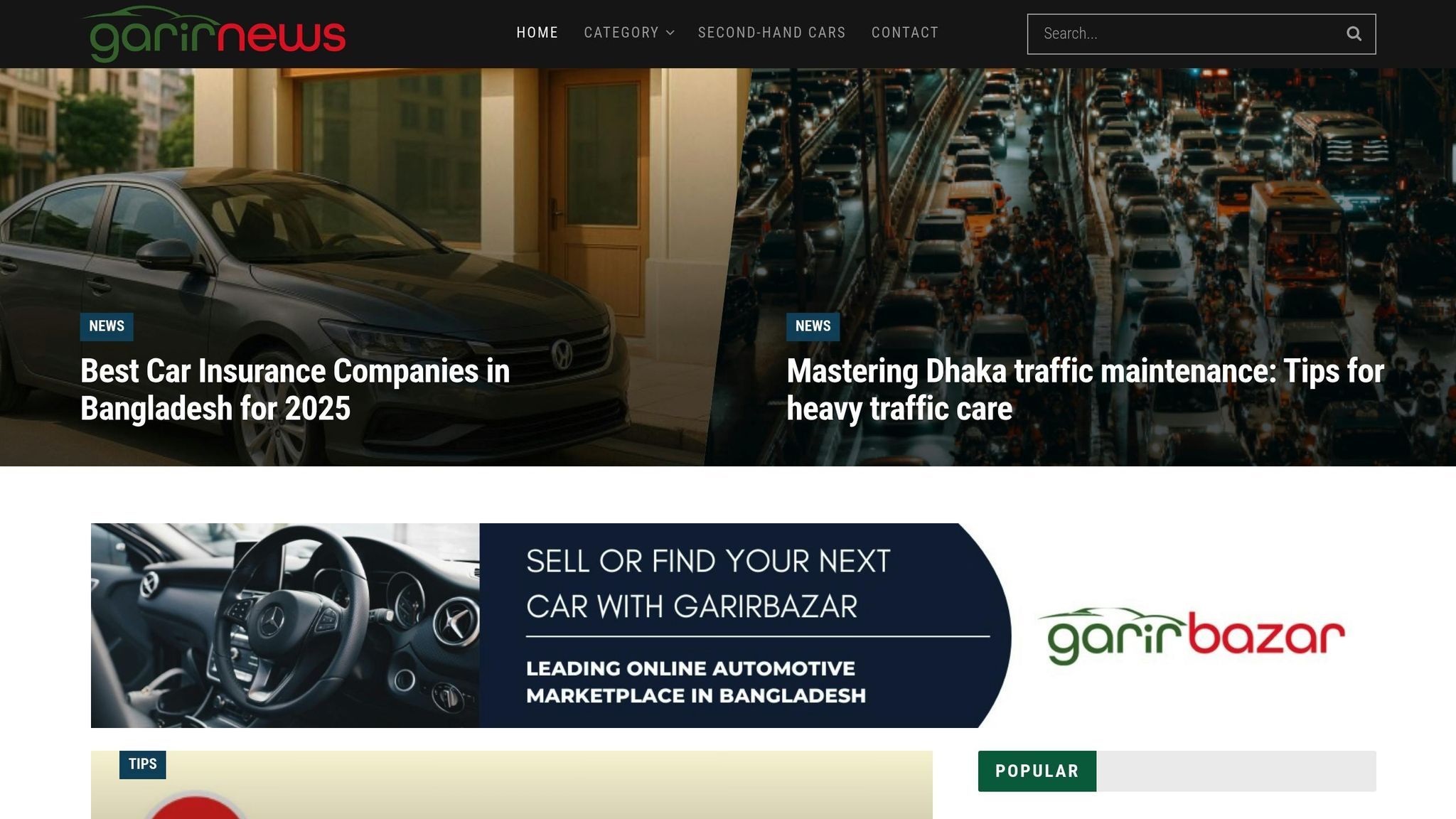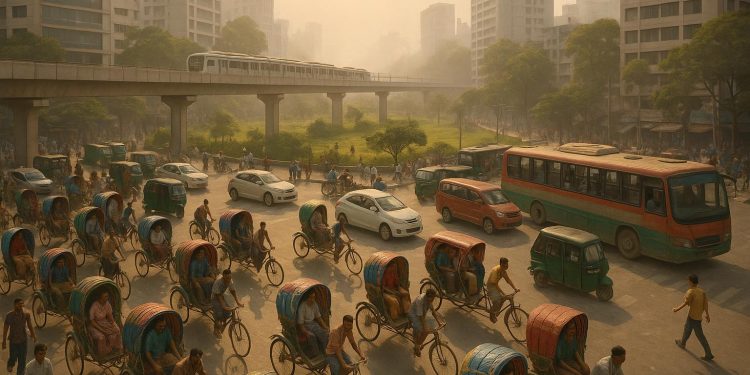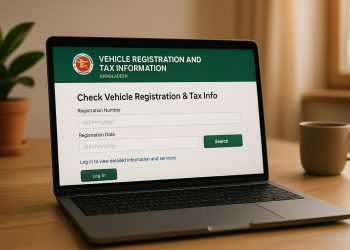Dhaka’s traffic problem is more than an inconvenience – it’s a daily struggle for millions, impacting the economy, health, and quality of life. The city’s rapid growth has outpaced its infrastructure, leading to severe congestion, pollution, and inefficiencies. Here’s what you need to know:
- Why it’s a problem: Long commutes, high fuel consumption, and air pollution harm public health and the economy. Inefficient public transport and overcrowded roads worsen the situation, especially for low-income residents.
- Root causes: Limited road space (only 7-8% of the city’s area), excessive private vehicles, and poor traffic management are key factors.
- Solutions in focus: Upgrading public transport like metro rail and electric buses, introducing smart traffic systems, and promoting walking, cycling, and green vehicles can ease congestion and reduce pollution.
Dhaka’s challenges are immense, but with better planning, technology, and community efforts, change is possible. The time to act is now.
DHAKA Traffic Chaos & Comprehensive Solution to it! – Professor M Shamim Z Bosunia
Main Causes of Dhaka’s Traffic Jams
To tackle Dhaka’s infamous traffic jams, it’s crucial to first understand the factors behind them. The city’s traffic woes are the result of interconnected issues that have worsened over time. At the heart of the problem lies inadequate road infrastructure, an overwhelming number of private vehicles, and ineffective traffic management.
Poor Road Systems
Dhaka’s road network is far from sufficient to meet the demands of its growing population. Roads make up just 7–8% of the city’s total area, a stark contrast to the 25% recommended for large urban centres. With such limited space for vehicles, the city struggles to handle its ever-increasing traffic load.
Too Many Private Cars
The sheer number of private vehicles on Dhaka’s roads is a major contributor to congestion. For every bus, there are 33 private cars, even though buses serve 49% of passengers, compared to just 13% who use private cars. Many residents avoid public transport due to its unreliability and safety concerns, opting instead for private cars or motorcycles. This shift only adds to the already overcrowded roads.
Bad Traffic Control
Dhaka’s traffic management systems are another weak point. The current average traffic speed is a painfully slow 6.4 kph, and if vehicle growth continues unchecked, this could drop to 4.7 kph by 2035. These figures highlight the urgent need for better traffic control strategies to prevent the city from grinding to a halt.
How Traffic Jams Affect Dhaka Residents
Traffic jams in Dhaka create a ripple effect of challenges, affecting the economy, environment, and daily lives of its residents in profound ways.
Financial Strain
The economic impact of Dhaka’s traffic congestion is hard to ignore. Hours spent stuck in traffic mean lost productivity, both for individuals and businesses. Families and companies also face rising costs due to increased fuel consumption and delays in deliveries. For emergency services, these delays can be life-threatening, as they hinder timely medical attention. Together, these issues not only hurt the economy but also amplify environmental concerns.
Pollution and Health Risks
The environmental toll of traffic congestion directly impacts public health. Vehicles idling in traffic pump harmful emissions into the air, worsening air quality. These pollutants are linked to respiratory illnesses, with children and the elderly being especially vulnerable. For those with pre-existing conditions, prolonged exposure can lead to severe complications. On top of this, the heat generated from exhaust emissions raises local temperatures, intensifying discomfort during Dhaka’s already hot and humid weather.
Social Challenges and Limited Access
The gridlock doesn’t just affect wallets and health – it also disrupts access to essential services. Unpredictable travel times can cause people to miss critical appointments, delay medical care, or skip school. For many, long and tiring commutes make it harder to find jobs or stay involved in their communities. This lack of mobility deepens social divides, as it limits opportunities for those already struggling. Addressing these barriers requires urgent and creative solutions in transportation planning.
sbb-itb-a58e215
Solutions for Dhaka’s Transport Problems
Dhaka’s traffic woes can be tackled by upgrading public transport systems and encouraging eco-friendly, non-motorised travel options. These changes can reduce congestion while improving urban living conditions.
Smart Traffic Control Systems
Advanced traffic management technologies could provide immediate relief for Dhaka’s notorious gridlock. For example, intelligent traffic signals that adjust to real-time conditions can cut down wait times at intersections. Similarly, GPS-based systems can monitor traffic flows, identifying congested areas and redirecting vehicles to less crowded routes.
Centralised digital traffic management centres can further streamline this process by coordinating traffic signals across multiple intersections. Cities that have implemented such systems have seen travel times during peak hours drop by 20-30%, demonstrating their potential for Dhaka.
Better Public Transport
Revamping Dhaka’s bus system with cleaner, more efficient vehicles can shift many commuters away from private cars. Electric buses are a great option, producing just 100 grams of CO₂ per mile compared to the 346 grams emitted by conventional cars. This not only helps the environment but also eases road congestion.
The Metro Rail project is another game-changer. By providing a fast and reliable alternative, it can transport thousands of passengers at once, significantly reducing the number of vehicles on the road. Additionally, introducing dedicated bus lanes and improving schedules can make public transport a more appealing choice for daily commuters.
Green Transport Options
For shorter trips, non-motorised transport like walking and cycling offers practical and eco-friendly solutions. A WBB Trust study in Dhaka led to the creation of 19 pedestrian crossings over a five-kilometre stretch, along with the deployment of 17 traffic officers. This initiative enabled over 3,000 pedestrians to cross safely.
Cycle rickshaws also play a vital role in the city’s transport ecosystem. They provide a pollution-free, affordable travel option while supporting the livelihoods of around 500,000 rickshaw pullers in Dhaka. To further promote green transport, dedicated cycling lanes and pedestrian walkways can make walking and cycling safer and more appealing.
Electric vehicles offer another cleaner alternative, emitting just 161 grams of CO₂ per mile compared to the 346 grams from conventional cars. Encouraging their use could significantly cut emissions and reduce reliance on traditional fuel-powered vehicles.
To truly address Dhaka’s traffic challenges, these measures must be part of a coordinated urban strategy that prioritises sustainability, mobility, and public health. By focusing on integrated solutions, the city can target its most congested areas and pave the way for lasting improvements.
Moving Forward: Plans for Better City Transport
Improving Dhaka’s transport system demands focused efforts and active community participation to tackle the city’s most congested areas. While earlier discussions highlighted smart systems and environmentally friendly transport options, the real change lies in combining infrastructure improvements with community-driven actions. Together, these steps can pave the way for a more efficient and sustainable transport network.
Fixing the Worst Traffic Spots
Addressing traffic bottlenecks in areas like Shahbagh, Farmgate, and the Gulistan-Paltan corridor can bring quick relief and set the tone for more extensive reforms.
- Redesigning intersections with dedicated turning lanes, better signal timing, and safe pedestrian crossings can help reduce conflicts between different road users. These targeted changes have already eased congestion for many.
- Flyovers and road widening projects can alleviate traffic but must be backed by thorough traffic impact studies to avoid simply moving the problem elsewhere.
- Adding emergency lanes can prevent minor accidents from causing massive peak-hour gridlocks.
Getting Communities Involved
Community engagement is key to reshaping transport habits and reducing reliance on private vehicles. Public awareness campaigns can encourage people to embrace alternatives like public transport, carpooling, and non-motorised travel.
- Schools and workplaces offer great opportunities for promoting better transport practices. Flexible work hours or office shuttle services can reduce rush-hour traffic, while schools encouraging walking or cycling create safer and healthier neighbourhoods.
- Local organisations can play a big role by promoting carpooling, advocating for better footpaths, or working with authorities to improve traffic management. Consistent messaging from these groups helps normalise sustainable travel habits.
How GarirNews Helps Promote Solutions

GarirNews complements these community efforts by keeping readers informed about the latest transport trends and solutions. It serves as a platform to educate people on topics like maintaining vehicles, improving fuel efficiency, and adopting eco-friendly driving habits. With in-depth reviews of electric and hybrid technologies, GarirNews empowers readers to make smarter, more sustainable choices. By providing practical advice, it supports responsible vehicle ownership and helps promote efficient use of resources across Bangladesh.
Conclusion: What’s Next for Dhaka
Dhaka’s traffic crisis is an urgent issue that demands attention. The city’s rapid growth has led to severe congestion, rising pollution, and significant economic challenges, affecting countless residents daily. However, as discussed earlier, there’s a path forward – a shift toward sustainable urban mobility through a combination of technology, infrastructure upgrades, and active community involvement.
Several promising initiatives are already paving the way. Efforts like smart traffic signals and the expansion of public transport systems, including electric buses and improved metro networks, are critical steps. Adding dedicated cycling lanes and promoting green transport options can help reduce pollution and cut fuel costs, while also boosting overall productivity.
Community participation plays a crucial role in achieving long-term change. Recent successes in easing congestion in specific areas highlight how collective efforts can make a real difference.
To move forward, Dhaka must embrace modern solutions. By integrating smart technologies, enhancing infrastructure, and fostering community engagement, the city can break free from outdated approaches to traffic management. Green mobility options, paired with intelligent systems, hold the promise of reducing environmental damage and improving the daily lives of its residents.
As Bangladesh continues its journey toward sustainable growth, Dhaka has the potential to set an example for other cities facing similar challenges. The investments made today in cleaner, smarter transportation systems will shape whether future generations inherit a city choked by traffic or a vibrant, well-connected urban hub. The time to act is now.
FAQs
What steps are being taken to improve Dhaka’s public transport system, and how will they benefit daily commuters?
Efforts to enhance Dhaka’s public transport system include introducing dedicated spaces for walking and cycling, such as bike lanes and skywalks, as part of the 2025 transport strategy. These steps aim to make daily travel safer and more convenient for pedestrians and cyclists alike.
In addition, the government plans to roll out 400 electric buses to the city’s fleet. This move is set to modernise public transportation, cut down air pollution, and offer more dependable services. Together, these initiatives are expected to ease traffic congestion, improve commute times, and support environmentally friendly urban mobility, ultimately elevating the daily lives of Dhaka’s residents.
What can Dhaka residents do to ease traffic congestion and support sustainable urban mobility?
Dhaka residents have the power to ease the city’s notorious traffic jams by making smarter commuting choices. For instance, using public transportation for daily travel and choosing to walk or cycle for short trips can significantly cut down the number of private vehicles on the roads. These steps not only help reduce congestion but also encourage greener, healthier travel habits.
Another practical solution is carpooling. Sharing rides with neighbours or colleagues can substantially lower the number of cars on Dhaka’s streets. On a broader scale, supporting measures like congestion charges or traffic management programmes can pave the way for smoother traffic flow and smarter mobility options.
Small changes in daily routines can collectively lead to a more efficient and sustainable urban transport system, making life a bit easier for everyone in the city.
How is technology helping to solve Dhaka’s traffic problems, and what solutions are being implemented?
Technology is stepping up to address Dhaka’s notorious traffic congestion, introducing smarter systems to make the city’s roads more manageable. A Traffic Management Centre has been established with a budget of Tk 89.3 million. This centre leverages real-time data to monitor and control traffic flow, aiming to ease congestion and improve mobility across the city.
In addition, automated traffic signals have been installed at key intersections, costing Tk 18 crore. These signals were designed to streamline vehicle movement, though their impact has been limited due to implementation challenges. Looking ahead, AI-powered intelligent transport systems are in the works, promising better traffic management, improved safety, and efficient solutions to meet the needs of Dhaka’s ever-expanding urban population.
Related Blog Posts
- Pros and Cons of Electric Cars in Bangladesh
- Toll Roads Impact Air Quality in Bangladesh
- Fuel Prices in Bangladesh: Impact on Driving and Car Ownership
- Bangladesh Car Market Forecast: What to Expect by 2030




